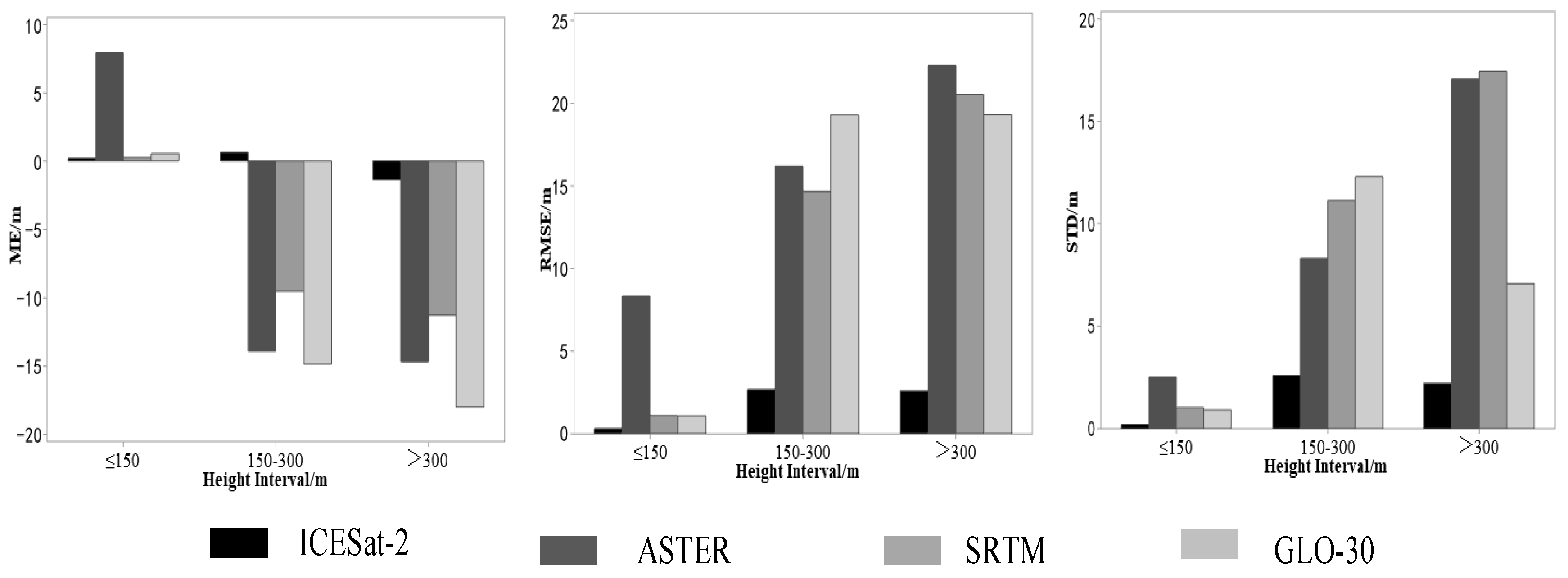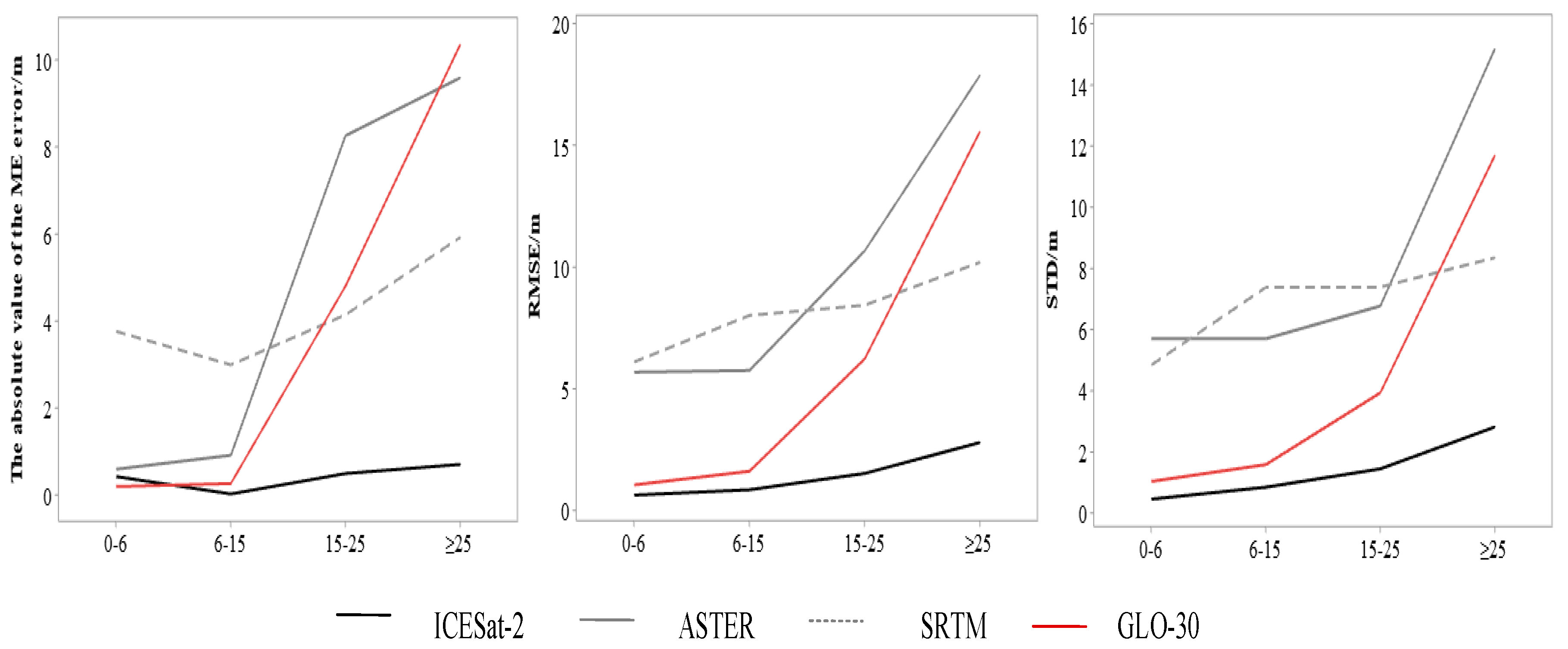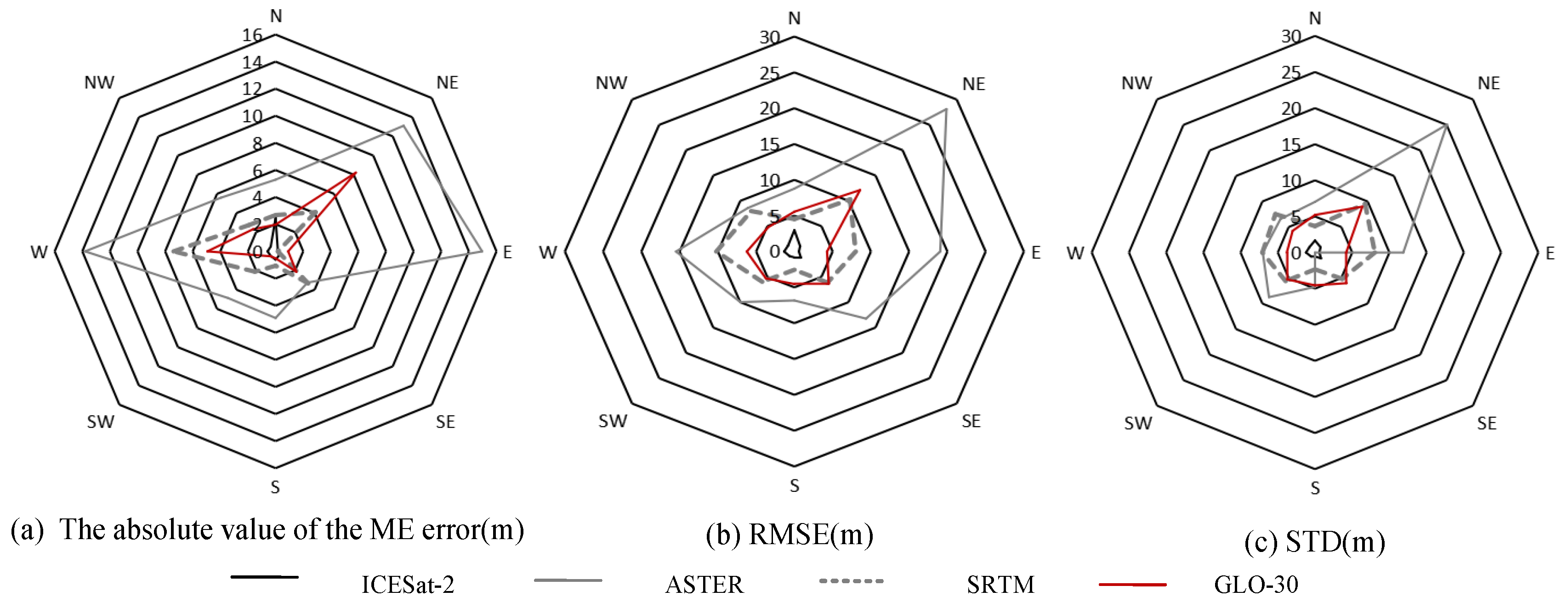Vertical Accuracy Assessment of the ASTER, SRTM, GLO-30, and ATLAS in a Forested Environment
Abstract
:1. Introduction
2. Study Material
2.1. Study Area
2.2. Study Data
2.2.1. ICESat-2/ATLAS Data Product
2.2.2. ASTER GDEM
2.2.3. SRTM DEM
2.2.4. GLO-30 DEM
2.2.5. G-LiHT Data
2.2.6. Forest Cover Data
3. Methods
- Study Area Selection
- 2.
- Extraction of ATL03 Product Information
- 3.
- Coordinate Transformation and Resampling
- 4.
- Ground Photon Selection
- 5.
- Generation of Slope and Aspect
- 6.
- Extraction of Elevation Data
- 7.
- Setting Elevation Difference Threshold
- 8.
- Evaluation of the Impact of Elevation, Slope, Aspect, and Land Cover Types on Topographic Errors
4. Results and Discussion
4.1. Overall Evaluation of the Elevation Accuracy
4.2. Influence of Ground Altitude on DEM Errors
4.3. DEM Precision under Different Forest Covers
4.4. Precision of the DEM at Different Slopes
4.5. Precision of DEMs at Different Aspects
4.6. Limitations of Our Study
5. Conclusions
- ICESat-2 ATL03 exhibits the highest accuracy in forest-covered regions. Its correlation coefficient (R2) with the reference DTM is closest to 1, with RMSE of 1.96 m and STD of 1.93 m. SRTM exhibits the highest accuracy at the regional scale, with an R2 close to 0.99, RMSE = 11.09 m, indicating higher accuracy compared to ASTER and GLO-30 products.
- The quality of the DEM products is related to the ground altitude. The accuracy of the four DEM products decreases with increasing sudden increases in altitude, such as in mountainous situations.
- The quality of DEM products is significantly affected by the slope factor. The accuracy of DEM products decreases with increasing slope, especially for slopes greater than 15°.
- Aspect and forest cover indeed influence the accuracy of the four DEM products, but this influence lacks a clear pattern.
Author Contributions
Funding
Data Availability Statement
Acknowledgments
Conflicts of Interest
References
- Lang, N.; Kalischek, N.; Armston, J.; Schindler, K.; Dubayah, R.; Wegner, J.D. Global canopy height regression and uncertainty estimation from GEDI LIDAR waveforms with deep ensembles. Remote Sens. Environ. 2022, 268, 112760. [Google Scholar] [CrossRef]
- Dubayah, R.; Blair, J.B.; Goetz, S.; Fatoyinbo, L.; Hansen, M.; Healey, S.; Hofton, M.; Hurtt, G.; Kellner, J.; Luthcke, S.; et al. The Global Ecosystem Dynamics Investigation: High-resolution laser ranging of the Earth’s forests and topography. Sci. Remote Sens. 2020, 1, 100002. [Google Scholar] [CrossRef]
- He, L.; Pang, Y.; Zhang, Z.; Liang, X.; Chen, B. ICESat-2 data classification and estimation of terrain height and canopy height. Int. J. Appl. Earth Obs. Geoinf. 2023, 118, 103233. [Google Scholar] [CrossRef]
- Liu, Z.; Zhu, J.; Fu, H.; Zhou, C.; Zuo, T. Evaluation of the Vertical Accuracy of Open Global DEMs over Steep Terrain Regions Using ICESat Data: A Case Study over Hunan Province, China. Sensors 2020, 20, 4865. [Google Scholar] [CrossRef]
- Yao, C.; Li, Z.J.; Zhang, K.; Huang, Y.C.; Wang, J.F.; Bastola, S. Evaluating performance dependency of a geomorphologic instantaneous unit hydrograph-based hydrological model on DEM resolution. Water Sci. Eng. 2022, 15, 179–188. [Google Scholar] [CrossRef]
- Li, W.; Li, D.; Fang, Z.N. Intercomparison of Automated Near-Real-Time Flood Mapping Algorithms Using Satellite Data and DEM-Based Methods: A Case Study of 2022 Madagascar Flood. Hydrology 2023, 10, 17. [Google Scholar] [CrossRef]
- Bernatek-Jakiel, A.; Jakiel, M. Identification of soil piping-related depressions using an airborne LiDAR DEM: Role of land use changes. Geomorphology 2021, 378, 107591. [Google Scholar] [CrossRef]
- Ye, Y.; Li, C.; Zeng, Y.; Tang, H. 3D DEM simulations of the variability of rock mechanical behaviour based on random rock microcracks. Int. J. Rock Mech. Min. Sci. 2023, 167, 105395. [Google Scholar] [CrossRef]
- Gunawardhana, N.L.; Al-rawas, A.G.; Baawain, S.M. Spatial regression approach to estimate synthetic unit hydrograph by geomorphic characteristics of watersheds in arid regions. J. Arid. Land 2020, 12, 950–963. [Google Scholar] [CrossRef]
- Waśniewski, A.; Hościło Agata, Z.B.; Moukétou, T.D. Assessment of Sentinel-2 Satellite Images and Random Forest Classifier for Rainforest Mapping in Gabon. Forests 2020, 11, 941. [Google Scholar] [CrossRef]
- Zeraatpisheh, M.; Ayoubi, S.; Sulieman, M.; Rodrigo-Comino, J. Determining the spatial distribution of soil properties using the environmental covariates and multivariate statistical analysis: A case study in semi-arid regions of Iran. J. Arid. Land 2019, 11, 551–566. [Google Scholar] [CrossRef]
- Pandit, A.; Ramsankaran, R.A.A.J.; Rao, Y.S. Generation and Validation of the Interferometric SAR DEMs from TanDEM-X data for Gangotri and Hamtah Glaciers of Indian Himalayas. Procedia Technol. 2014, 16, 793–805. [Google Scholar] [CrossRef]
- Hao, X.; Zhang, H.; Wang, Y.; Wang, J. A framework for high-precision DEM reconstruction based on the radargrammetry technique. Remote Sens. Lett. 2019, 10, 1123–1131. [Google Scholar] [CrossRef]
- Liu, Z.; Xu, B.; Cheng, B.; Hu, X. Interpolation Parameters in Inverse Distance-Weighted Interpolation Algorithm on DEM Interpolation Error. J. Sens. 2021, 2021, 1–14. [Google Scholar] [CrossRef]
- Zarco-Tejada, P.J.; Diaz-Varela, R.; Angileri, V.; Loudjani, P. Tree height quantification using very high resolution imagery acquired from an unmanned aerial vehicle (UAV) and automatic 3D photoreconstruction methods. Eur. J. Agron. 2014, 55, 89–99. [Google Scholar] [CrossRef]
- del Rosario González-Moradas, M.; Viveen, W. Evaluation of ASTER GDEM2, SRTMv3.0, ALOS AW3D30and TanDEM-X DEMs for the Peruvian Andes against highly accurate GNSS ground control points and geomorphological-hydrological metrics. Remote Sens. Environ. 2020, 237, 111509. [Google Scholar] [CrossRef]
- Li, Y.; Fu, H.; Zhu, J.; Wu, K.; Yang, P.; Wang, L.; Gao, S. A Method for SRTM DEM Elevation Error Correction in Forested Areas Using ICESat-2 Data and Vegetation Classification Data. Remote Sens. 2022, 14, 3380. [Google Scholar] [CrossRef]
- Hubacek, M.; Brenova, M.; Ceplova, L. Verification of accuracy of the new generation elevation models. Adv. Mil. Technol. 2014, 9, 21–32. [Google Scholar]
- Mahesh, R.; Sarunjith, K.J.; Rajakumari, S.; Muruganandam, R.; Ramesh, R. Quality assessment of open sourced digital elevation models in southeast coast of India. Egypt. J. Remote Sens. Space Sci. 2021, 24, 745–754. [Google Scholar] [CrossRef]
- Bhardwaj, A. Investigating the Terrain Complexity from ATL06 ICESat-2 Data for Terrain Elevation and Its Use for Assessment of Openly Accessible InSAR Based DEMs in Parts of Himalaya’s. Eng. Proc. 2021, 10, 65. [Google Scholar]
- Vassilaki, D.; Stamos, A. Tan DEM-X DEM: Comparative performance review employing LIDAR data and DSMs. ISPRS J. Photogramm. Remote Sens. 2020, 160, 33–50. [Google Scholar] [CrossRef]
- Qiujia, L.; Jing, L.; Xinyun, C. Accuracy evaluation of open DEM products based on airborne LiDAR data. J. Wuhan Univ. (Inf. Sci. Ed.) 2022, 1–16. [Google Scholar] [CrossRef]
- Shan, J.; Tian, X.; Li, S.; Li, R. Progress in high technology of satellite-borne laser measurement. J. Surv. Mapp. 2022, 51, 964–982. [Google Scholar]
- Neuenschwander, A.L.; Magruder, L.A. The Potential Impact of Vertical Sampling Uncertainty on ICESat-2/ATLAS Terrain and Canopy Height Retrievals for Multiple Ecosystems. Remote Sens. 2016, 8, 1039. [Google Scholar] [CrossRef]
- Ranndal, H.; Sigaard Christiansen, P.; Kliving, P.; Baltazar Andersen, O.; Nielsen, K. Evaluation of a Statistical Approach for Extracting Shallow Water Bathymetry Signals from ICESat-2 ATL03 Photon Data. Remote Sens. 2021, 13, 3548. [Google Scholar] [CrossRef]
- Herzfeld, U.C.; Lawson, M.; Trantow, T.; Nylen, T. Airborne Validation of ICESat-2 ATLAS Data over Crevassed Surfaces and Other Complex Glacial Environments: Results from Experiments of Laser Altimeter and Kinematic GPS Data Collection from a Helicopter over a Surging Arctic Glacier (Negribreen, Svalbard). Remote Sens. 2022, 14, 1185. [Google Scholar] [CrossRef]
- Zhu, X.; Sheng, N.; Cheng, W.; Xiaohuan, X.; Dong, L.; Guoyuan, L.; Pu, W.; Di, C.; Xuebo, Y. Estimating Terrain Slope from ICESat-2 Data in Forest Environments. Remote Sens. 2020, 12, 3300. [Google Scholar] [CrossRef]
- Xing, Y.; Huang, J.; Gruen, A.; Qin, L. Assessing the Performance of ICESat-2/ATLAS Multi-Channel Photon Data for Estimating Ground Topography in Forested Terrain. Remote Sens. 2020, 12, 2084. [Google Scholar] [CrossRef]
- Liu, A.; Cheng, X.; Chen, Z. Performance evaluation of GEDI and ICESat-2 laser altimeter data for terrain and canopy height retrievals. Remote Sens. Environ. 2021, 264, 112571. [Google Scholar] [CrossRef]
- Lao, J.; Wang, C.; Zhu, X.; Xi, X.; Nie, S.; Wang, J.; Cheng, F.; Zhou, G. Retrieving building height in urban areas using ICESat-2 photon-counting LiDAR data. Int. J. Appl. Earth Obs. Geoinf. 2021, 104, 102596. [Google Scholar] [CrossRef]
- Markus, T.; Neumann, T.; Martino, A.; Abdalati, W.; Brunt, K.; Csatho, B.; Farrell, S.; Fricker, H.; Gardner, A.; Harding, D.; et al. The Ice, Cloud, and land Elevation Satellite-2 (ICESat-2): Science requirements, concept, and implementation. Remote Sens. Environ. 2017, 190, 260–273. [Google Scholar] [CrossRef]
- Neumann, T.; Brenner, A.; Hancock, D.; Robbins, J.; Saba, J.; Harbeck, K.; Gibbons, A.; Lee, J.; Luthcke, S.; Rebold, T. ICE, CLOUD, and Land Elevation Satellite-2 (ICESat-2) Project Algorithm Theoretical Basis Document (ATBD) for Global Geolocated Photons ATL03 (Version 4). 2021. Available online: https://icesat-2.gsfc.nasa.gov/sites/default/files/page_files/ICESat2_ATL02_ATBD_r003.pdf (accessed on 30 May 2023).
- Lin, X.; Xu, M.; Cao, C.; Dang, Y.; Bashir, B.; Xie, B.; Huang, Z. Estimates of Forest Canopy Height Using a Combination of ICESat-2/ATLAS Data and Stereo-Photogrammetry. Remote Sens. 2020, 12, 3649. [Google Scholar] [CrossRef]
- Chirico, P.G.; Malpeli, K.C.; Trimble, S.M. Accuracy Evaluation of an ASTER-Derived Global Digital Elevation Model (GDEM) Version 1 and Version 2 for Two Sites in Western Africa. GIScience Remote Sens. 2013, 49, 775–801. [Google Scholar] [CrossRef]
- Reuter, H.I.; Nelson, A.; Jarvis, A. An evaluation of void-filling interpolation methods for SRTM data. Int. J.Geogr. Inf. Sci. 2007, 21, 983–1008. [Google Scholar] [CrossRef]
- John, M.B. Caveats Concerning the Use of SRTM DEM Version 4.1 (CGIAR-CSI). Remote Sens. 2016, 8, 793. [Google Scholar]
- Purinton, B.; Bookhagen, B. Beyond Vertical Point Accuracy: Assessing Inter-pixel Consistency in 30 m Global DEMs for the Arid Central Andes. Front. Earth Sci. 2021, 9, 758606. [Google Scholar] [CrossRef]
- Cook, B.D.; Corp, L.A.; Nelson, R.F.; Middleton, E.M.; Morton, D.C.; McCorkel, J.T.; Masek, J.G.; Ranson, K.J.; Ly, V.; Montesano, P.M. NASA Goddard’s LiDAR, Hyperspectral and Thermal (G-LiHT) Airborne Imager. Remote Sens. 2013, 5, 4045–4066. [Google Scholar] [CrossRef]
- Zhang, X.; Liu, L.; Chen, X.; Gao, Y.; Xie, S.; Mi, J. GLC_FCS30: Global landcover product with fine classification system at 30 m using time-series Landsat imagery. Earth Syst. Sci. Data 2021, 13, 2753–2776. [Google Scholar] [CrossRef]
- Madson, A.; Sheng, Y. Automated Water Level Monitoring at the Continental Scale from ICESat-2 Photons. Remote Sens. 2021, 13, 3631. [Google Scholar] [CrossRef]
- Gao, Z.; Xie, Y.; Wang, N.; Jiang, J.; Zhou, P. Response of three global DEM data accuracy to different terrain factors in Qinghai-Tibet Plateau. Bull. Soil Water Conserv. 2019, 39, 184–191. [Google Scholar]
- Neuenschwander, A.L.; Magruder, L.A. Canopy and Terrain Height Retrievals with ICESat-2: A First Look. Remote Sens. 2019, 11, 1721. [Google Scholar] [CrossRef]
- Osama, N.; Shao, Z.; Ma, Y.; Yan, J.; Fan, Y.; Habib, S.M.; Freeshah, M. The ATL08 as a height reference for the global digital elevation models. Geo-Spat. Inf. Sci. 2022, 1–20. [Google Scholar] [CrossRef]







| Data Name | Release Time | Version | Data Form | Coordinate System | Resolution |
|---|---|---|---|---|---|
| ICESat-2/ATLAS | 2018 | V6 | Spot data | WGS-84 | The spot diameter is about 17 m. |
| ASTER DEM | 2019 | v3 | Raster data | WGS-84 | 30 m |
| SRTM DEM | 2003 | V4.1 | Raster data | WGS-84 | 30 m |
| GLO-30 | 2019 | GLO-30 | Raster data | WGS-84 | 30 m |
| G-LiHT DTM | 2010 | - | Raster data | NAVD88 | 1 m |
| GLC_FCS30 | 2020 | 2020 | Raster data | WGS-84 | 30 m |
| Study Area | ATLAS | G-LIHT Acquisition Time | G-LIHT File Name | |
|---|---|---|---|---|
| ATL03 | ATL08 | |||
| Aiken | ATL03_20191102023411_05530502_005_01.h5 | ATL08_20191102023411_05530502_005_01.h5 | 2011 | AMIGACarb_Augusta_FIA_Sep2011_l3s566_DTM.tif |
| AMIGACarb_Augusta_FIA_Sep2011_l41s559_DTM.tif | ||||
| California | ATL03_20190902081319_10120402_005_01.h5 | ATL08_20190902081319_10120402_005_01.h5 | 2012 | GLDTMT_AMIGACarb_G10_Sep2012_l3s669_DTM.tif |
| GLDTMT_AMIGACarb_FB3_FIA_Sep2012_l6s12_DTM.tif | ||||
| Puerto Rico | ATL03_20210419235943_04001101_005_01.h5 | ATL08_20210419235943_04001101_005_01.h5 | 2017 | GLDTMT_PR_13March2017_FIA26_l0s15_DTM.tif |
| GLDTMT_PR_13March2017_FIA35_l0s10_DTM.tif | ||||
| GLDTMT_PR_12March2017_48_mosaic_DTM.tif | ||||
| Accuracy Evaluation Indicators | Aiken | California | Puerto Rico | |||||||||
|---|---|---|---|---|---|---|---|---|---|---|---|---|
| ICESat-2 | ASTER | SRTM | GLO-30 | ICESat-2 | ASTER | SRTM | GLO-30 | ICESat-2 | ASTER | SRTM | GLO-30 | |
| R2 | 1 | 0.95 | 0.97 | 0.99 | 0.99 | 0.94 | 0.97 | 0.97 | 1 | 0.98 | 0.98 | 0.99 |
| ME/m | 0.22 | 7.95 | 0.30 | 0.55 | 1.06 | 9.26 | 17.33 | 23.90 | 0.08 | 18.62 | 2.03 | 6.32 |
| RMSE/m | 0.31 | 8.13 | 1.08 | 1.07 | 3.38 | 12.05 | 18.57 | 24.61 | 1.68 | 20.28 | 10.70 | 11.81 |
| STD/m | 0.22 | 2.51 | 1.04 | 0.91 | 3.21 | 7.74 | 6.69 | 5.89 | 1.68 | 8.06 | 10.53 | 10.00 |
| Accuracy Evaluation Indicators | ICESat-2 | ASTER | SRTM | GLO-30 |
|---|---|---|---|---|
| R2 | 1 | 0.99 | 0.99 | 1 |
| ME/m | 0.36 | −3.76 | −5.01 | −7.79 |
| RMSE/m | 1.96 | 13.47 | 11.09 | 14.10 |
| STD/m | 1.93 | 12.94 | 9.90 | 11.76 |
Disclaimer/Publisher’s Note: The statements, opinions and data contained in all publications are solely those of the individual author(s) and contributor(s) and not of MDPI and/or the editor(s). MDPI and/or the editor(s) disclaim responsibility for any injury to people or property resulting from any ideas, methods, instructions or products referred to in the content. |
© 2024 by the authors. Licensee MDPI, Basel, Switzerland. This article is an open access article distributed under the terms and conditions of the Creative Commons Attribution (CC BY) license (https://creativecommons.org/licenses/by/4.0/).
Share and Cite
Huang, J.; Yu, Y. Vertical Accuracy Assessment of the ASTER, SRTM, GLO-30, and ATLAS in a Forested Environment. Forests 2024, 15, 426. https://doi.org/10.3390/f15030426
Huang J, Yu Y. Vertical Accuracy Assessment of the ASTER, SRTM, GLO-30, and ATLAS in a Forested Environment. Forests. 2024; 15(3):426. https://doi.org/10.3390/f15030426
Chicago/Turabian StyleHuang, Jiapeng, and Yang Yu. 2024. "Vertical Accuracy Assessment of the ASTER, SRTM, GLO-30, and ATLAS in a Forested Environment" Forests 15, no. 3: 426. https://doi.org/10.3390/f15030426





